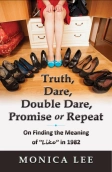It’s Throwback Thursday at Minnesota Wonderer, and today we’re grateful for an 8-pound miniature schnauzer.
Ten-year-old Chloe contracted pneumonia recently, and her very life hung in the balance for a few days. The vet recommended an overnight stay in an oxygen tent (to the tune of $1,000+), but we settled on a round of antibiotics and lots of pampering. She barely ate anything for a week (her weight dipping to a boney 6.8 pounds), and she started experiencing seizures again.
Her epilepsy, which was diagnosed a few years ago, had been under control with medication, but something about the pneumonia (breathing problems? stress of a visit to the vet? lack of sleep? antibiotics?) was causing breakthrough seizures.
Oh, God, not this again.
That was two weeks ago, and the good news is, she’s on the mend, but the whole experience reminded me of when she first started having seizures, which I recount in this post from Feb. 9, 2014.
A story about canines (both species and the teeth), Rimadyl and patience
Caregiving is stressful.
By telling the story below, I don’t mean to minimize caregivers of human patients who I realize most certainly are far more invested in their patients and the stakes are far higher. I can’t even imagine the stress of a someone whose wife has dementia or whose child is battling cancer.
The past 48 hours around here were tough in a much smaller, 8.4-pound way.
My dog (yes, this is a pet story — if you don’t like domestic animals, you’re hereby excused) had her teeth cleaned Friday.
Apparently, dogs bite when strangers stick their hands in their mouths (who knew?), so veterinarians anesthetize dogs in order to clean their teeth.
(Seriously? Dogs require dental care? Yes, I was incredulous, too. My miniature schnauzer had bad breath for years — literally years — and I came to love her stinky mouth. Yellow teeth? Who cares? She’s a dog, right? That’s what I thought until one of her teeth literally fell out of her mouth in my Beloved’s gentle fingers. It was so decayed, it was rotten. Rotten teeth, as it turns out, not only cause bad breath, they cause gum disease which can lead to terrible things like organ failure and death. It was clear my lame tooth-brushing routine was doing no good, and my sweet dog’s teeth required professional intervention. And so, D-Day, that is, Dental Day, came on Friday.)
She remained at the veterinary clinic all day. Anesthesia is serious business, you know. As this was the first time my dear Chloe was undergoing such a procedure, you can imagine the mess the technician found. Five teeth were so rotten they had to be extracted.
“How will she eat?” I lamented. Even toothless dogs figure out how to consume hard dog food pellets, I was told. Survival instinct, I guess. These creatures sometimes eat rabbit turds and lap up muddy puddles, so they’re not too discerning, I guess.
She was ready for pick-up at 5 p.m. and though she was generally listless, she looked OK. And her teeth were sparkling. I’m not kidding. They’re whiter than my teeth now.
I carefully listened to the after-care instructions, which included doses of pain killer and antibiotics and took her home. She sat on the couch with my Beloved and though she acted weird once, gacking strangely, we simply took her to bed as usual.
Then the horror began.
She started experiencing a seizure every two hours all night long. After the first one, I took her off the bed and put her in her kennel next to the bed, but I woke up every time her little legs violently pummeled the kennel from the inside.
You can’t stop a seizure. You can only speak softly and gently hold the victim (or, if they’re bigger than my little dog, get out of the way) while you wait for the gagging and the foaming and wide eyes and open mouth and kicking to subside. Forty seconds feels like 5 minutes. In the moments after the seizure, the victim still isn’t really there, looking spacy and stumbling around in a haze. I could only hold her sweaty body, feeling her racing heartbeat.
I’ve never had babies, so I don’t know what it’s like caring for a sick child through the night. But I can tell you caring for a sick pet is no walk in the park. Every moment waiting for another seizure was torture.
We stupidly followed the dosing instructions the following morning, giving her 25 mg of the antibiotic Clindamycin and 6.25 mg of Rimadyl, a pain reliever. The seizures occurred less frequently but did not abate.
I finally got in touch with the vet who assured me neither the anesthesia nor the medications could be causing seizures. She wanted to examine her and do more blood work (which they did only 24 hours previously before surgery), and she suggested maybe injecting an anti-seizure medication.
Great. I’d already paid $461 for the tooth cleaning surgery and $343 for the extractions. For that, my sweet little dog with bad breath had turned into a convulsing mess with sparkling teeth.
I should mention my dog continued to eat, drink, pee and poop as usual, so her systems seemed to operating normally except for the occasional brain reboot in the form of an ugly seizure. Seizures are caused by many real ailments and should not be left untreated (I am not a vet and I don’t play one on TV), but they also occur for unknown reasons, and it seemed clear the vet knew no more than I did. Like a lot of doctors, she wanted to do more tests and administer more drugs. Ugh.
Like all modern patients, we resorted to internet diagnosis, and we didn’t like what found online about Rimadyl. Correlation does not imply causation, but what’s the variable here? Chloe was perfectly healthy and seizure-free before surgery.
So we stopped the meds.
And Chloe slept peacefully through the night.
 This morning, we gave her half the antibiotic and no pain medication. She was back to her frisky self, galloping around the house, bounding down the stairs and barking her obnoxious-but-joyful-to-hear bark.
This morning, we gave her half the antibiotic and no pain medication. She was back to her frisky self, galloping around the house, bounding down the stairs and barking her obnoxious-but-joyful-to-hear bark.
She clearly was not in pain.
I share this story both as a warning (beware of Rimadyl) and as a lesson.
As I waited those long moments through Chloe’s convulsions, I reminded myself of the body’s power to heal, that time heals all wounds, that patience is a virtue. There was no other balm for this chaos and stress but to accept it and embrace it and move through it. My prayers were answered (yes, I wasted God’s time with the health of a dog — what’s time to an eternal being?). And I’m so grateful.







 This morning, we gave her half the antibiotic and no pain medication. She was back to her frisky self, galloping around the house, bounding down the stairs and barking her obnoxious-but-joyful-to-hear bark.
This morning, we gave her half the antibiotic and no pain medication. She was back to her frisky self, galloping around the house, bounding down the stairs and barking her obnoxious-but-joyful-to-hear bark.







